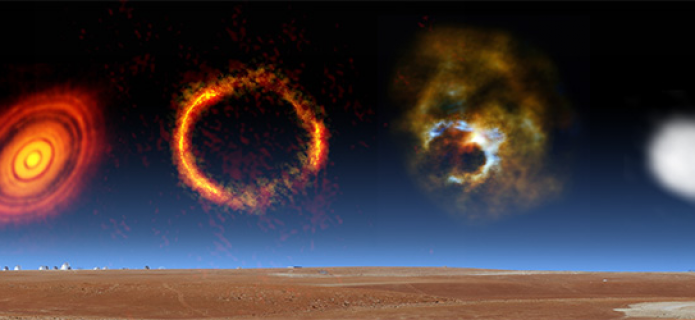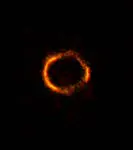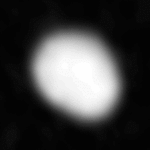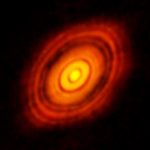ALMA Partnership Publishes First Results on Long Baselines
Unprecedented views of the surface of asteroid Juno and the Einstein Ring of a distant galaxy have recently been captured in images taken by the Atacama Large Millimeter/submillimeter Array (ALMA). These stunning images were taken at the end of 2014 as part of ALMA's Long Baseline Campaign, with the goal of testing and verifying the telescope's highest resolving power, achieved when the antennas are at their greatest separation: up to 15 kilometers apart.
"It takes a combination of ALMA's high resolution and high sensitivity to unlock these otherwise hidden details of the Universe," said ALMA Director Pierre Cox.
Five targets were selected for this ALMA Campaign, including asteroid Juno, the protoplanetary disk HL Tau, the gravitationally lensed galaxy SDP.81, the evolved star Mira, and the quasar 3C138. The Astrophysical Journal, Letters has published four scientific papers written by representatives of the entire international team of the ALMA Partnership, detailing these observations.
The Long Baseline Campaign captured the highest resolution images ever taken with this state-of-the-art instrument, giving astronomers an unprecedented view of the distant galaxy SDP.81that-- seen from Earth with the aid of a gravitational lens -- appears like a cosmic ring [image 1].

Image 1. ALMA image of the gravitationally lensed galaxy SDP.81. The bright orange central region of the ring (ALMA's highest resolution observation ever) reveals the glowing dust in this distant galaxy. The surrounding lower-resolution portions of the ring trace the millimeter wavelength light emitted by carbon monoxide. Credit: ALMA (NRAO/ESO/NAOJ); B. Saxton NRAO/AUI/NSF
Forged by the chance alignment of two distant galaxies, the more distant one magnified by the gravitational pull of the intervening one located between the distant source and the Earth, SDP.81 is a gravitationally lensed object known as an Einstein Ring. A manifestation of Einstein's Theory of General Relativity, gravity acted like an optical lens, bending the light to magnify the image of the distant galaxy and producing a distorted arc-shaped image as seen from the Earth.
"This is a major accomplishment for ALMA's high-resolution capabilities," said ALMA Deputy Program Scientist Catherine Vlahakis. These ALMA observations achieved a resolution as fine as 23 milliarcseconds, which is a first for telescopes that operate at these wavelengths, rivaling even the Hubble Space Telescope.
Another series of images made with ALMA provided an unprecedented view of the surface of Juno, one of the largest members of our Solar System's main asteroid belt. Linked together into a brief animation, these high-resolution images show the asteroid rotating through space as it shines in millimeter-wavelength light [image 2].

Image 2. Animation of the asteroid Juno as imaged by ALMA as part of the telescope's Long Baseline Campaign. Images were taken when Juno was approximately 295 million kilometers from Earth. Credit: ALMA (NRAO/ESO/NAOJ)
The complete ALMA observation was conducted over the course of four hours when Juno was approximately 295 million kilometers from Earth. For this observation, ALMA achieved a resolution of 40 milliarcseconds, meaning that each "pixel" in the images is about 60 kilometers across, covering approximately one-fourth of the surface of Juno. This resolution is a vast improvement over earlier observations made at similar wavelengths and is enough to clearly resolve the shape of the asteroid and potentially tease out prominent surface features.
"This new observation clearly demonstrates that ALMA is a very powerful tool for studying asteroids and shows the ability to image the surface of many Solar System bodies better than any other instrument," added ALMA astronomer Ed Fomalont.
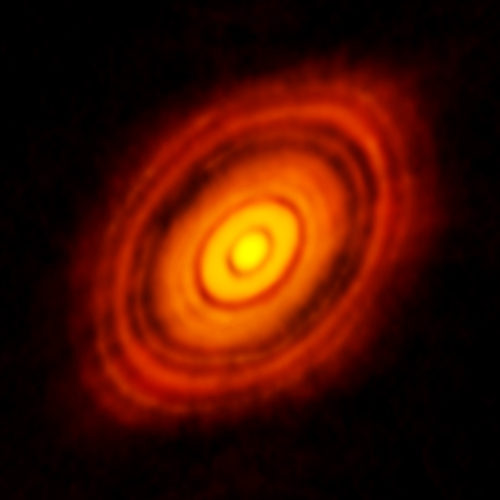
Image 3. This image shows the protoplanetary disc surrounding the young star HL Tauri. These new ALMA observations reveal substructures within the disc that have never been seen before and even show the possible positions of planets forming in the dark patches within the system. Credit: ALMA (ESO/NAOJ/NRAO)
Another target was the proto-planetary disc HL Tau, whose results observation represented an enormous step forward in the understanding of how these discs develop and how planets form.
The five objects were chosen to show the scientific potential of ALMA, the world's largest ground-based observatory, in its most extended configuration.
More information
The paper, "ALMA Long Baseline Observations of the Strongly Lensed Submillimeter Galaxy HATLAS J090311.6+003906 at z=3.042", is located here: https://arxiv.org/abs/1503.02652
The paper, "ALMA Observations of Asteroid 3 Juno at 60 Kilometer Resolution", is located here: https://arxiv.org/pdf/1503.02650.pdf
The paper, "First Results From High Angular Resolution ALMA Observations Toward the HL Tau Region", is located here: https://arxiv.org/pdf/1503.02649.pdf
The Atacama Large Millimeter/submillimeter Array (ALMA), an international astronomy facility, is a partnership of the European Organisation for Astronomical Research in the Southern Hemisphere (ESO), the U.S. National Science Foundation (NSF) and the National Institutes of Natural Sciences (NINS) of Japan in cooperation with the Republic of Chile. ALMA is funded by ESO on behalf of its Member States, by NSF in cooperation with the National Research Council of Canada (NRC) and the Ministry of Science and Technology (MOST) in Taiwan and by NINS in cooperation with the Academia Sinica (AS) in Taiwan and the Korea Astronomy and Space Science Institute (KASI).
ALMA construction and operations are led by ESO on behalf of its Member States; by the National Radio Astronomy Observatory (NRAO), managed by Associated Universities, Inc. (AUI), on behalf of North America; and by the National Astronomical Observatory of Japan (NAOJ) on behalf of East Asia. The Joint ALMA Observatory (JAO) provides the unified leadership and management of the construction, commissioning and operation of ALMA.
Contact:
Valeria Foncea
Education and Public Outreach Officer
Joint ALMA Observatory
Santiago, Chile
Tel: +56 2 467 6258
Cell: +56 9 75871963
Email: [email protected]
Charles E. Blue
Public Information Officer
National Radio Astronomy Observatory
Charlottesville, Virginia, USA
Tel: +1 434 296 0314
Cell: +1 434.242.9559
E-mail: [email protected]
Richard Hook
Public Information Officer, ESO
Garching bei München, Germany
Tel: +49 89 3200 6655
Cell: +49 151 1537 3591
Email: [email protected]
Masaaki Hiramatsu
Education and Public Outreach Officer, NAOJ Chile
Observatory Tokyo, Japan
Tel: +81 422 34 3630
E-mail: [email protected]
